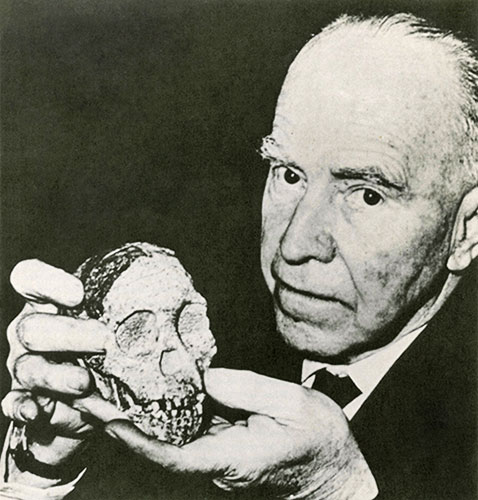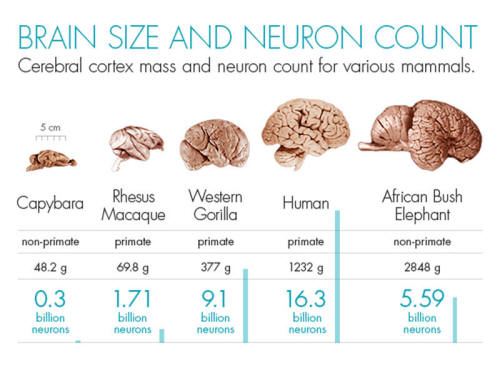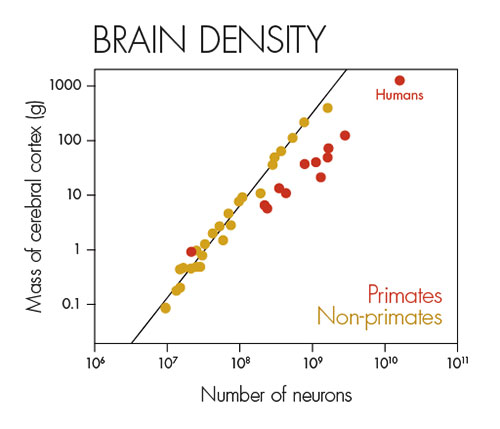|
from QuantaMagazine Website
the symphony of biological triggers that powered the extraordinary expansion of the human brain.
There it was, sitting on the mantelpiece, staring at her with hollow eyes and a naked grin.
She could not stop staring back. It looked distinctly like the fossilized skull of an extinct baboon. That was the sort of thing Josephine Salmons was likely to know.
At the time - 1924 - she was one of the only female students of anatomy attending the University of the Witwatersrand in South Africa. On this particular day she was visiting her friend Pat Izod, whose father managed a quarry company that had been excavating limestone near the town of Taung.
Workers had unearthed numerous fossils during the excavation, and the Izods had kept this one as a memento. Salmons brought news of the skull to her professor, Raymond Dart, an anthropologist with a particular interest in the brain.
He was incredulous. Very few primate fossils had been uncovered this far south in Africa.
If the Taung site really housed such
fossils, it would be an invaluable treasure trove. The next morning
Salmons brought Dart the skull, and he could see that she was right:
The skull was undeniably simian.
Later that year, as he was preparing to attend a close friend's wedding, he received a large crate. One of the specimens it contained was so mesmerizing that he nearly missed the ceremony.
It came in two pieces:
Dart noticed right away that this was the fossil of an extinct ape, not a monkey. The teeth suggested that the individual had died at age 6 or so.
The point where the spinal cord had joined the skull was too far forward for a knuckle walker, indicating bipedalism. And the endocast, which was a little too large for a nonhuman ape of that age, had surface features characteristic of a human brain.
After further study, Dart reached a bold conclusion:
At first, the greater scientific community lambasted Dart's proposal.
If the Taung child, as the fossil was nicknamed, truly belonged to a hominin, surely it would have a far larger brain. Its cranium was a bit bigger than that of a chimpanzee, but not by much. Besides, it was generally believed that humans had evolved in Asia, not Africa.
The "absurdly tiny" illustration accompanying Dart's 1925 Nature paper (Australopithecus Africanus - The Man-Ape of South Africa), and his initial possessiveness of the specimen, did not help matters. Eventually, though, as prominent experts got to see the Taung child for themselves, and similar fossil discoveries came to light, attitudes began to change.
By the 1950s, anthropologists had accepted that Taung was indeed a hominin and that an exceptionally large brain had not always been a distinguishing characteristic of humans.
Dean Falk, a professor of anthropology at Florida State University and an expert on brain evolution, has called the Taung child,
In subsequent decades, by uncovering and comparing other fossil skulls and endocasts, paleontologists documented one of the most dramatic transitions in human evolution.
We might call it the 'Brain Boom'...
Humans, chimps and bonobos split from their last common ancestor between 6 and 8 million years ago. For the next few million years, the brains of early hominins did not grow much larger than those of our ape ancestors and cousins.
Starting around 3 million years ago, however, the hominin brain began a massive expansion.
By the time our species, Homo sapiens, emerged about 200,000 years ago, the human brain had swelled from about 350 grams to more than 1,300 grams. In that 3-million-year sprint, the human brain almost quadrupled the size its predecessors had attained over the previous 60 million years of primate evolution.
Fossils established the Brain Boom as fact. But they tell us next to nothing about how and why the human brain grew so large so quickly.
There are plenty of theories, of course, especially regarding why:
Although these possibilities are fascinating, they are extremely difficult to test.
In the last eight years, however, scientists have started to answer the "how" of human brain expansion - that is, the question of how the supersizing happened on a cellular level and how human physiology reconfigured itself to accommodate a dramatically enlarged and energy-guzzling brain.
What Makes the Human Brain Special
One scientist, in particular, has transformed the way researchers size up brains.
Rather than fixating on mass or volume as a proxy for brainpower, she has focused on counting a brain's constituent parts.
In her laboratory at the Institute of Biomedical Sciences at the Federal University of Rio de Janeiro, Suzana Herculano-Houzel routinely dissolves brains into a soup of nuclei - cells' genetic control rooms.
Each neuron has one nucleus. By tagging the nuclei with fluorescent molecules and measuring the glow, she can get a precise tally of individual brain cells.
Using this method on a wide variety of mammalian brains, she has shown that, contrary to long-standing assumptions, larger mammalian brains do not always have more neurons, and the ones they do have are not always distributed in the same way.
Olena
Shmahalo/Quanta Magazine;
The human brain has 86 billion neurons in all:
In contrast, the elephant brain, which is three times the size of our own, has 251 billion neurons in its cerebellum, which helps manage a giant, versatile trunk, and only 5.6 billion in its cortex.
Considering brain mass or volume alone masks these important distinctions.
Based on her studies, Herculano-Houzel has concluded that primates evolved a way to pack far more neurons into the cerebral cortex than other mammals did.
The great apes are tiny compared to elephants and whales, yet their cortices are far denser:
Of all the great apes, we have the largest brains, so we come out on top with our 16 billion neurons in the cortex.
In fact, humans appear to have the most cortical neurons of any species on Earth.
It's all about the architecture, not just size.
The human brain is also unique in its unsurpassed gluttony. Although it makes up only 2 percent of body weight, the human brain consumes a whopping 20 percent of the body's total energy at rest.
In contrast, the chimpanzee brain needs only half that. Researchers have long wondered how the human body adapted to sustain such a uniquely ravenous organ.
In 1995, the anthropologist Leslie Aiello and the evolutionary biologist Peter Wheeler proposed the "expensive tissue hypothesis" as a possible answer.
The underlying logic is straightforward: Human brain evolution likely required a metabolic trade-off. In order for the brain to grow, other organs, namely the gut, had to shrink, and energy that would typically have gone to the latter was redirected to the former.
For evidence, they pointed to data showing that primates with larger brains have smaller intestines.
A few years later, the anthropologist Richard Wrangham built on this idea, arguing that the invention of cooking was crucial to human brain evolution. Soft, cooked foods are much easier to digest than tough raw ones, yielding more calories for less gastrointestinal work.
Perhaps, then, learning to cook permitted a bloating of the human brain at the expense of the gut. Other researchers have proposed that similar trade-offs might have occurred between brain and muscle, given how much stronger chimps are than humans.
Collectively, these hypotheses and observations of modern anatomy are compelling. But they are based on the echoes of biological changes that are thought to have occurred millions of years ago.
To be certain of what happened, to pinpoint the physiological adaptations that made the brain's evolutionary growth spurt possible, we will have to dive deeper than flesh, into our very genome.
Olena
Shmahalo/Quanta Magazine;
How Genes Build the Brain
About eight years ago, Gregory Wray and his colleagues began to investigate a family of genes that influence the movement of glucose into cells to be used as energy.
One member of the gene family is especially active in brain tissue, whereas another is most active in muscle. If the size of the human brain required a metabolic trade-off between brain tissue and muscle, then these genes should behave differently in humans and chimpanzees.
Wray and his team collected brain, muscle and liver samples from deceased humans and chimpanzees and attempted to measure gene activity in each sample.
When a cell "expresses" a gene, it translates the DNA first into a signature messenger RNA (mRNA) sequence and subsequently into a chain of amino acids that forms a protein. Varying levels of distinct mRNAs can therefore provide a snapshot of gene activity in a particular type of tissue.
Wray's team extracted mRNA from the tissues and amplified it many times over in the lab in order to measure the relative abundance of different mRNAs.
They found that the brain-centric glucose-transporting gene was 3.2 times more active in human brain tissue than in the chimp brain, whereas the muscle-centric gene was 1.6 times more active in chimp muscle than in human muscle.
Yet the two genes behaved similarly in the liver of both species.
Given that the human and chimp gene sequences are nearly identical, something else must explain their variable behavior. Wray and his colleagues found some intriguing differences between the genes' corresponding regulatory sequences - stretches of DNA that stimulate or stifle gene activity.
In humans, but not in chimps, the regulatory sequences for the muscle and brain-focused glucose-transporting genes had accumulated more mutations than would be expected by chance alone, indicating that these regions had undergone accelerated evolution.
In other words, there was a strong evolutionary pressure to modify the human regulatory regions in a way that sapped energy from muscle and channeled it to the brain.
Genes had corroborated the expensive tissue hypothesis in a way fossils never could.
Last year, the computational biologist Kasia Bozek, who now works at the Okinawa Institute for Science and Technology in Japan, published a similar study that examined metabolism from a different angle.
In addition to looking at gene expression, Bozek and her colleagues analyzed levels of metabolites, a diverse group of small molecules that includes sugars, nucleic acids and neurotransmitters. Many metabolites are either necessary for metabolism or produced by it.
Different organs have distinct metabolite profiles, depending on what they do and how much energy they require. In general, metabolite levels in the organs of closely related species are more in sync than levels between distantly related species.
Bozek found that the metabolite profiles of human and chimp kidneys, for example, were pretty similar.
But the variation between chimp and human brain metabolite levels was four times higher than would be expected based on a typical rate of evolution; muscle metabolites differed from the expected levels by a factor of seven.
"It wasn't just a couple mutations and - bam! - you get a bigger brain."
Bozek and her colleagues then pitted 42 humans, including college basketball players and professional rock climbers, against chimpanzees and macaques in a test of strength.
All of the primates had to pull a sliding shelf saddled with weights toward themselves. Accounting for body size and weight, the chimps and macaques were twice as strong as the humans.
It's not entirely clear why, but it is possible that our primate cousins get more power out of their muscles than we get out of ours because they feed their muscles more energy.
Meanwhile, Wray had turned to his Duke colleague Debra Silver, an expert in embryonic brain development, to embark on a pioneering experiment.
Not only were they going to identify relevant genetic mutations from our brain's evolutionary past, they were also going to weave those mutations into the genomes of lab mice and observe the consequences.
The researchers began by scanning a database of human accelerated regions (HARs); these regulatory DNA sequences are common to all vertebrates but have rapidly mutated in humans.
They decided to focus on HARE5, which seemed to control genes that orchestrate brain development.
The human version of HARE5 differs from its chimp correlate by 16 DNA letters. Silver and Wray introduced the chimpanzee copy of HARE5 into one group of mice and the human edition into a separate group.
They then observed how the embryonic mice brains grew.
After nine days of development, mice embryos begin to form a cortex, the outer wrinkly layer of the brain associated with the most sophisticated mental talents. On day 10, the human version of HARE5 was much more active in the budding mice brains than the chimp copy, ultimately producing a brain that was 12 percent larger.
Further tests revealed that HARE5 shortened the time required for certain embryonic brain cells to divide and multiply from 12 hours to nine.
Mice with the human HARE5 were creating new neurons more rapidly.
But she also stressed that it will take a great deal more research to fully answer how the human brain blew up.
Wray concurs:
Brain and Body
Although the mechanics of the human brain's expansion have long been mysterious, its importance has rarely been questioned.
Again and again, researchers have cited the evolutionary surge in human brain size as the key reason for our exceptionally high degree of intelligence compared to other animals. As recent research on whale and elephant brains makes clear, size is not everything, but it certainly counts for something.
The reason we have so many more cortical neurons than our great-ape cousins is not that we have denser brains, but rather that we evolved ways to support brains that are large enough to accommodate all those extra cells.
There's a danger, though, in becoming too enamored with our own big heads.
Yes, a large brain packed with neurons is essential to what we consider high intelligence. But it's not sufficient.
Consider, for a moment, what the world would be like if dolphins had hands. Dolphins are impressively brainy. They have demonstrated self-awareness, cooperation, planning and the rudiments of language and grammar.
Compared to apes, though, they are severely limited in their ability to manipulate the world's raw materials. Dolphins will never enter the Stone Age; flippers cannot finesse.
Similarly, we know that chimps and bonobos can understand human language and even form simple sentences with touch-screen keyboards, but their vocal tracts are inadequate for producing the distinct series of sounds required for speech.
Conversely, some birds have the right vocal anatomy to flawlessly mimic human speech, but their brains are not large enough or wired in the right way to master complex language.
No matter how large the human brain grew, or how much energy we lavished upon it, it would have been useless without the right body.
Three particularly crucial adaptations worked in tandem with our burgeoning brain to dramatically increase our overall intelligence:
Human intelligence, then, cannot be traced to a single organ, no matter how large; it emerged from a serendipitous confluence of adaptations throughout the body.
Despite our ongoing obsession with the size of our noggins, the fact is that our intelligence has always been so much bigger than our brain...
and artwork by MRK for Quanta Magazine with art direction by Olena Shmahalo/Quanta Magazine
|




